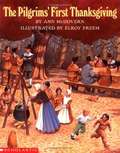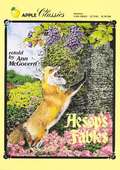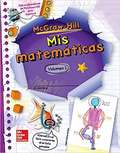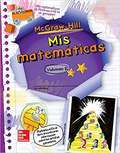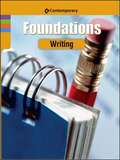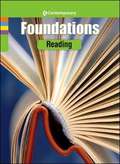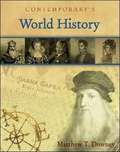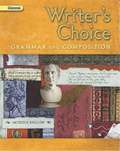- Table View
- List View
More NIMAC books are available at www.nimac.us. If you find your title in the NIMAC and not in Bookshare then please contact us to request it.
Trevor's Big Adventure / Red-Eyed Tree Frog (Fountas & Pinnell Classroom, Guided Reading)
by Alice McGinty Michelle Olmsted Eugenia NobatiNIMAC-sourced textbook
The Pilgrims' First Thanksgiving
by Ann McGovernNIMAC-sourced textbook <P><P>Elroy Freem (the pseudonym of a popular children's book artist) gives this reissue of a favorite story new life. Teachers, parents, and children will give thanks for this easy-to-read, larger format book with lively, full-color illustrations.
Shark Lady: True Adventures of Eugenie Clark
by Ann Mcgovern Ruth ChewA biography of the ichthyologist whose interest in fish began at the age of nine during weekly trips to the Aquarium in New York City. Copyright © Libri GmbH. All rights reserved.
Aesop’s Fables
by Ann Mcgovern A. J. McclaskeySixty-seven familiar and not so familiar fables from Aesop, including the tortoise and the hare, the frogs who wanted a king, the lion who fell in love, and the donkey who danced on the roof.
If You Lived in Colonial Times (If You Lived Ser.)
by Ann McGovern June OtaniNIMAC-sourced textbook
The Motata Tree: An African Folktale (Fountas & Pinnell Classroom, Guided Reading)
by Kate McGovern Sue ToddNIMAC-sourced textbook. Name That Tree! The animals on the African plain haven't eaten in days. Then they find a very tall tree filled with ripe and colorful fruit. But how will they ever reach the fruit of this magical tree?
The Power of Style (Fountas & Pinnell Classroom, Guided Reading)
by Brian McGrathNIMAC-sourced textbook. EGYPT UFELE was bullied in school because she was different. At first, learning to sew was a way of forgetting her pain and loneliness. But within a few years, she went from making clothes for her dolls to designing chic outfits for herself. When she was invited to show her clothing collection at New York City Fashion Week, this tween fashionista realized her talent and effort had won out over the bullies.
Ready for Takeoff: How Flying Cars Work (Fountas & Pinnell Classroom, Guided Reading)
by Brian McGrathNIMAC-sourced textbook
K-Pop: More than a Music Sensation / Boot Camp: Becoming a K-Pop Star (Fountas & Pinnell Classroom, Guided Reading Grade 6)
by Brian McGrath Yishan LiNIMAC-sourced textbook
McGraw-Hill My Math, Grade 5, Spanish Student Edition, Volume 1 (Elementary Math Connects)
by McGraw Hill Education StaffNIMAC-sourced textbook
McGraw-Hill My Math, Grade 5, Spanish Student Edition, Volume 2 (Elementary Math Connects)
by McGraw Hill Education StaffNIMAC-sourced textbook
Contemporary Foundations: Writing
by McGraw Hill Wright GroupContemporary'sFoundationsseries helps students improve their basic skills. Each book provides skill instruction, offers interesting passages to study, and furnishes opportunities for practice.Foundationsprovides meaningful contexts for learning, using language which is easy to understand. Foundations: Writingwill help students improve their writing skills, as well as their reading and thinking skills. Part I: Writing helps students practice the four stages of the writing process: Prewriting: planning and organizing Drafting: writing by following a plan Revising: evaluating and rewriting Editing: correcting grammar, mechanics, and usage Students will learn about five types of essays and practice writing each type: Descriptive Essay Personal Narrative How-To Essay Essay of Example Comparison-and-Contrast Essay Part II: Grammar focuses on language skills that writers need to understand. Grammar: nouns, pronouns, verbs, adjectives, and adverbs Punctuation: periods, question marks, exclamation marks, commas, and semicolons Sentence Structure: incomplete sentences, run-on sentences, and comma splices The following special features will help students practice their writing skills. In Your Journal: ideas to think about and write about on your own Language Tip: explanations, pronunciations, study hints, and background information that will help students understand what they read Test Skills: a reminder that this skill is often tested on standardized tests With a Partner: reading, writing, and thinking activities to do with a classmate, family member, or friend Posttest: a test, evaluation chart, and answer key to guage skill mastery Revised Edition Features: New language tips Updated content, including revised passages, updated graphs and images More exercises About the Series: In Foundations: Reading, students will read practical information, nonfiction, poetry, and short stories. They will learn to find the main point and the details; identify fact, opinion, and bias; make inferences; read photographs and cartoons; and understand rhythm, rhyme, plot, and theme. Writing Workshops, Language Tips, and prereading questions are designed to improve reading, writing, and thinking skills. In Foundations: Writing, students will practice the four steps to writing an essay: prewriting, drafting, revising, and editing. They will read and write five kinds of essays: descriptive essays, personal narratives, how-to essays, essays of example, and comparison-and-contrast essays. A language-skills workbook provides grammar, punctuation, and sentence structure practice. In Your Journal, With a Partner, and Language Tipswill help students become better writers, and better readers and thinkers as well. In Foundations: Science, students will learn about the human body, plant biology, physics, chemistry, and Earth science. They will practice putting events in order; reading diagrams, charts, and graphs; using the scientific method; and making comparisons and contrasts. Try It yourself!activities will guide students through simple experiments so they will have a better understanding of what they have been reading about. Writing Workshops and Language Tips will help students use their reading and writing skills to think about science topics. In Foundations: Social Studies, students will learn about world history, U.S. history, civics and government, geography, and economics. They will summarize, make predictions, infer the main idea of cartoons, find information on maps, and read various kinds of graphs. Background Information, Language Tips, and Writing Workshops will let students use what they already know as they read and write about social studies topics. The revised edition includes a new World History chapter. In Foundations: Math, students will practice using whole numbers, money, decimals, fractions, ratios, and percents. Exercises will help students review the addition, subtraction, multiplication, and division facts; round numbers; estimate answers; and solve word problems. Math Notes, On their Calculator, and Language Ti...
Simple Solutions, Common Core Mathematics 5
by Nancy L. McGraw Donna M. Mazzola Nancy TondyNIMAC-sourced textbook
Contemporary Foundations: Reading
by McGraw-HillContemporary's Foundations series helps students improve their basic skills. Each book provides skill instruction, offers interesting passages to study, and furnishes opportunities for practice. Foundations provides meaningful contexts for learning, using language which is easy to understand. About Foundations: Reading, Revised Edition: Foundations: Reading will help students improve their reading ability, as well as their writing and thinking skills. Foundations: Reading is divided into four units: Practical Reading: ''survival'' reading that you do everyday. Practical reading includes instructions, advertisements, and explanations. Reading Nonfiction: writing based on facts. Nonfiction includes newspaper and magazine articles, books about real people and real events, and encyclopedia articles. Reading Poetry: verse that captures a person's feelings. Learning to recognize form, rhythm, rhyme, and images will help you read and appreciate poetry. Reading Short Fiction: stories created from an author's imagination. Characters, setting, plot, and theme are important elements in every story. These special features in Foundations: Reading will help students practice language skills: Writing Workshops: detailed instructions that will guide the student through the four-step writing process: prewriting, drafting, revising, and editing Language Tips: explanations, pronunciations, study hints, and background information that will help the student understand what he or she is reading Test Skills: a reminder that this skill is often tested on standardized tests Posttest: a test, evaluation chart, and answer key, to gauge the mastery of each skill. Revised Edition Features: New language tips, Updated content, including revised passages, updated graphs and images, More exercises. About the Series: In Foundations: Reading, students will read practical information, nonfiction, poetry, and short stories. They will learn to find the main point and the details; identify fact, opinion, and bias; make inferences; read photographs and cartoons; and understand rhythm, rhyme, plot, and theme. Writing Workshops, Language Tips, and prereading questions are designed to improve reading, writing, and thinking skills. In Foundations: Writing, students will practice the four steps to writing an essay: prewriting, drafting, revising, and editing. They will read and write five kinds of essays: descriptive essays, personal narratives, how-to essays, essays of example, and comparison-and-contrast essays. A language-skills workbook provides grammar, punctuation, and sentence structure practice. In Your Journal, With a Partner, and Language Tips will help students become better writers, and better readers and thinkers as well. In Foundations: Science, students will learn about the human body, plant biology, physics, chemistry, and Earth science. They will practice putting events in order; reading diagrams, charts, and graphs; using the scientific method; and making comparisons and contrasts. Try It yourself! activities will guide students through simple experiments so they will have a better understanding of what they have been reading about. Writing Workshops and Language Tips will help students use their reading and writing skills to think about science topics. In Foundations: Social Studies, students will learn about world history, U.S. history, civics and government, geography, and economics. They will summarize, make predictions, infer the main idea of cartoons, find information on maps, and read various kinds of graphs. Background Information, Language Tips, and Writing Workshops will let students use what they already know as they read and write about social studies topics. The revised edition includes a new World History chapter. In Foundations: Math, students will practice using whole numbers, money, decimals, fractions, ratios, and percents. Exercises will help students review the addition, subtraction, multiplication, and division facts; round numbers; estimate answers; and solve word problems. Math Notes, On their Calculator, and Language ...
Contemporary's World History: Blackline Masters [Grade 6-12]
by McGraw-HillWorld History, written at the 5 to 8 reading level, is an integrated series of print and electronic resources designed to provide a complete classroom solution for students who need extra support. Every chapter and lesson in the student book contains features and activities to keep students engaged in the learning process. The student CD-ROM, the Annotated Teacher's Edition, and the Teacher's Resource Binder all provide additional materials for English Language Learners. World Historyincorporates the National Council for the Social Studies (NCSS) high school thematic strands. The book covers events beginning with pre-history and continues through the modern era. ANCILLARY MATERIALS Student Edition CD-ROM PDFs of all student book pages Audio narration of each page in the student book Spanish audio introduction of each key chapter concept Spanish audio ELL activity for each chapter Four instructional, activities per chapter Student Presentation Builder Interactive historical timeline Interactive Glossary Annotated Teacher's Edition Reduced student pages with wrap-around teacher notes Teaching objectives for each lesson Lists of classroom materials Extension activities Vocabulary lessons Literary connections Classroom discussions Teacher's Resource Binder Includes Annotated Teacher's Edition 160 blackline masters, eight per chapter, consisting of a reading comprehension activity a vocabulary reinforcement activity an additional biography an additional primary source document a map activity a chapter activity a chapter review a chapter quiz 20 full-color overhead transparencies CD-ROM consisting of the following PDFs entire Annotated Teacher's Edition one test per unit one full book assessment one ELL reading activity per chapter one ELL vocabulary activity per chapter one puzzle per chapter
Decodable Stories Takehome Books, Blackline Masters, Level 2 [Grade 2]
by McGraw-HillNIMAC-sourced textbook
Florida Wonders, Grade 4 Literature Anthology (Florida Wonders)
by McGraw-HillNIMAC-sourced textbook
Florida Wonders Grade 4, Reading/Writing Companion: Units 5 - 6 (Florida Wonders)
by McGraw-HillNIMAC-sourced textbook

